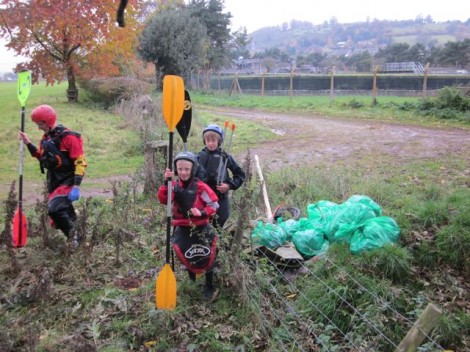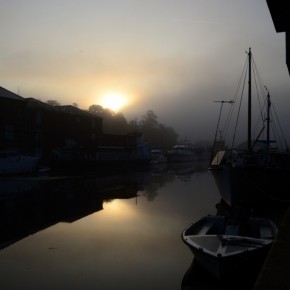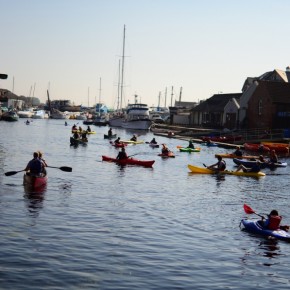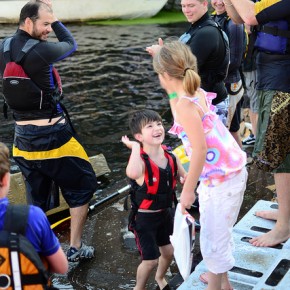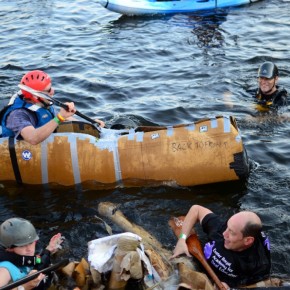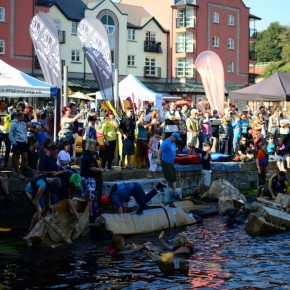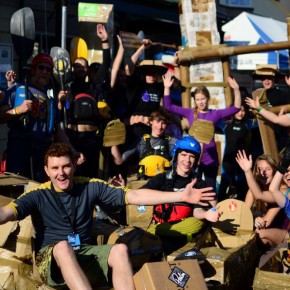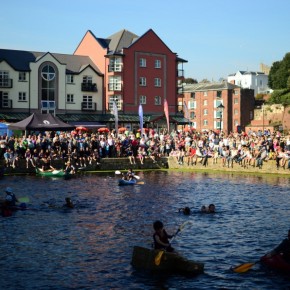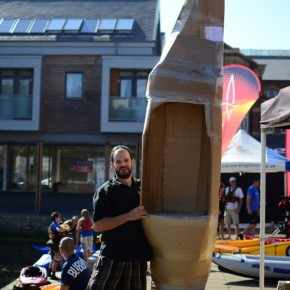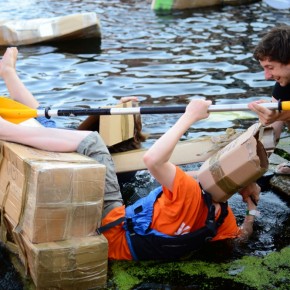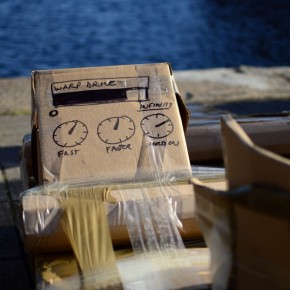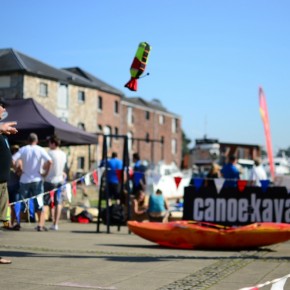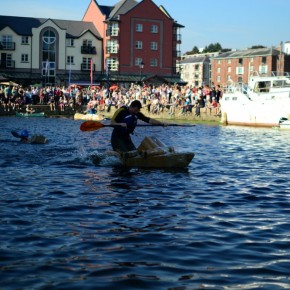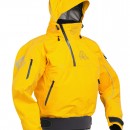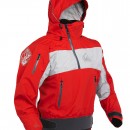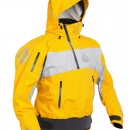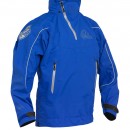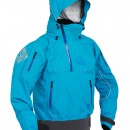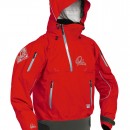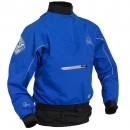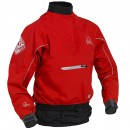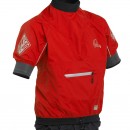Shaking off sleep from Saturday’s ever-successful South West canoe show, the team were on site early on Sunday to set up the Exe Big paddle.
It didn’t take long for the Piazza to take on the appearance of a festival site, with tents, bunting and boats all creating a mass of colour ready for paddlers to arrive….. Which they did, right on the dot at 9am.
First up were the tours, fully booked out months in advance, the groups were keen to get out and learn about the nature and history of the Exe and adjacent shipping canal. We were fantastically lucky to have staff from the RSPB, Devon Wildlife Trust and an ex head of the Archaeology society as our guides so those lucky enough to secure a place came back a few hours later full of enthusiasm for what they’d learnt and seen on the five mile loop.
Meanwhile on the Piazza, the sunshine brought a great mix of participants, including passers-by keen to have a go at kayaking and canoeing for the first time. Our seasoned team from Bristol based canoe lifesaving club, Globe 360, were constantly busy and had to add boats to the pool of demos available as more and more people got out on the water.
Helping entice folk into giving it a go were the popular Canoe England ergo machines. Racing over a 100m sprint, young and old gave it their all through the day trying to better a time set by development racer Michael Sims and to get a top ranking on the Top Gear style leader board. Predictably no-one beat Michael’s time, but that’s what you’d hope with a national level athlete and it didn’t stop lucky winners getting their prizes!
The CKUK Magazine Throwbag Challenge also drew a crowd each time someone stepped up to throw the rope bag into a boat, gradually getting further away each time they threw. The winners managed an impressive 20-metre throw with pinpoint accuracy to win a year’s magazine subscription, although technique advice from the sidelines seemed as abundant as those trying!
As the afternoon came around so did preparations for the finale of the day: The cardboard canoe race. Starting quietly with boat building by Palm and AS Watersports’ staff, the ‘workshop’ area soon became a teaming mass of people cutting, folding and taping card into weird a wacky shapes.
As building finished, a parade of boats (if you can call some of them that) let head judge Ben Hedden from Haven Banks Activity centre scrutinize designs, before giving the entrants the go ahead to proceed. By now the banks were lined with spectators and, amidst the expected carnage, boats set off to try and get around a marker buoy.
Success was not widespread with some who’d put creativity in front of water tightness literally falling at the first splash. However the crowd began to roar as the first ‘floaters’ made it around the buoy and back on the home straight. At best many made one lap, including an ingenious catamaran design from the local deaf school, but as cheers continued a junior and senior race winner soon became obvious, as they were the only ones still afloat. Congratulations to Sea Hare and Back-to-Front, winners of the first ever Exe Cardboard Canoe Race!
Tea and medals swiftly followed and the tiring task of packing it all away began.
It was a great event, fulfilling the aims of the Big Paddle by showcasing the sport to new participants and widening the scope for those who already take part, all in aid of charitable causes, which for the Exe event were Devon Hospice care and the Canoe Foundation.
Events such as this are only possible with the dedication and help from volunteers. So to AS Watersports, Canoe England, Haven Banks, Exeter Canoe Club, Globe 360, CKUK the Palm team, and all of you who attended – a Big Paddle thanks.
Look out for the full report in the December issue of Canoe Kayak UK Magazine. Until then, we hope you enjoy these shots. Massive thanks to Daniel Bewsey for capturing the event for us. For the whole gallery see Dan’s Big Paddle Flickr Album.
More information about the Big Paddle events: www.thebigpaddle.com
We have spent the past week paddling on Lake Athabasca. After making our way off of the Tazin River through a series of lakes and portages, we came out onto the big lake near the community of Camsell Portage. It is a very small town, but they do have all the modern conveniences – electricity thanks to nearby hydroelectric dams, phone service, and even internet via satellite.

Dave and I were thrilled to have a chance to spend some time talking with Phillip and Mary Stenne. We learned about life in Camsell Portage back in the old days. It used to be much bigger when the El Dorado mine near Uranium City was functioning. That is actually what brought Phillip to the area 60 years ago, but he left the mine rather quickly in favor of living in Camsell Portage, fishing, trapping, and cutting survey lines for mineral exploration. Now Mary and Phillip are 2 of the 8 people living in this tiny town.
We left Camsell Portage in a light headwind. Little did we know that headwind, from the east would be with us basically the entire way. The north shore of Lake Athabasca reminded us very much of home – that is, the north shore of Lake Superior. The coast is almost entirely granite. Wave action keeps even lichen from growing on several meters of the pink rock along shore. We have enjoyed the varied scenery of many points, bays, and islands.

Being out on this big body of water, it has been a great spot to view the surrounding landscape, enjoying seeing the green healthy spruce and jack pine in patches. However, we have also seen several large sections that have burned not too long ago. Just a little dusting of green shrubs are visible among the blackened rock and standing dead timber, as the forest slowly returns.
We chose to take a short cut near Uranium City, following the river and a series of lakes through the peninsula instead of paddling all the way around. This way was significantly shorter, but the water in the river was really low and we portaged a bit more than we would have liked. It was a relief to cut from Beaver Lodge Lake, following the winter road, back out to Lake Athabasca.

Since the shortcut, we have been on an evening paddling schedule in order to avoid the stronger wind that seems to pick up during the day. This works well, as it never gets completely dark. The sun dips below the horizon around 10:30 PM but there is still a faint glow in the northern sky until the sun rises around 3:30 AM. Fennel has been well fed on fish. The other day, Dave caught a really big lake trout – the biggest one he’s ever caught.
We passed by Fon du Lac, stopping briefly to pick up a couple treats at the grocery store. Last night we paddled through Pine Channel and now we are within a day’s paddle of Stony Rapids. From there we will leave the big water behind for a while.
Have you ever seen a forest fire up close? Well we hadn’t until this past week. On Tuesday as we left Hill Island Lake, we could see smoke toward the south but we figured that it was a long ways away. On Wednesday, the plumes of smoke grew closer and closer as we paddled south on the Tazin River.

By lunch time we were pretty sure that the fire was near our route. The view upriver was one thick, low-lying cloud of smoke. We called the ENR (Environment and Natural Resources) in Fort Smith to see if they knew of any fires in our area. We found out that there were three fires not very far away from us. The one of concern was burning near the Northwest Territories, Saskatchewan border.
We were about five miles from the border. We proceeded with caution, but only made it another couple of miles after lunch. The eastern side of the river was on fire. Not only did we see thick clouds of smoke billowing up from the spruces, but we saw patches of flames here and there. Fortunately for us, the wind was blowing the smoke away from us.
A gravel bar provided us with a perfect spot to stop and watch what was going on upriver. We waited there for several hours. We set up our tent and ate dinner as we observed the smoke and flames creep ever closer to the eastern shore of the river. After several hours the fire had reached the river’s edge and a small stand of Jack Pine ignited in a plume of flames and smoke. In less than a minute the ¼ mile section of the river near us had erupted in flames. The raw energy of the fire became very real as we felt the heat and listened to the inferno. All we could to is stand in awe.

Within 10 minutes the flames were gone, leaving a giant stand of black smoking tree trunks. We decided the fire was getting too close for comfort so we packed up the canoe and retreated north, hoping the fire would die down overnight and let us pass in the morning.
As we slept the fire jumped the river and continued burning to the west. Small fires burned on both sides of the river and the smoke-filled river channel was not very inviting. We called the ENR again and learned that they were sending a helicopter out later in the day to get a look at the fire. So we decided to take it easy and wait. Around 3 PM we heard the drone of the chopper and watched as it came in for a landing on the gravel beach 100 feet from us. Two ENR officers in yellow jumpsuits hopped out and explained that the fire had burned out along most of the river and that the “head” of the fire had moved several miles west of the river. They advised that we paddle through the recently burned area right way because the winds were predicted to change overnight.

We casually chatted for a few minutes and then they hopped back in the helicopter and flew way. We were left a little dumbfounded, but excited about continuing our journey. As we paddle through the smoke filled channel, we marveled at the blackened trees and patches of green left by the fire. Small fires still burned on both sides of the river, but we never felt in danger. We paddled well into the night talking about the natural phenomenon we had just witnessed, finally stopping to pitch out tent many miles from the fire at 1 AM.
Is the Wilderness system Tempest a fast boat, is it stable and can it deal with the rough stuff ? Well I raced a plastic tempest 170 down the river Ness last weekend in the annual Ness marathon 2011 short course and managed to win, beating the other entrants and coming only 30 second slower than the course record which was set in a wild water racer, so fast yes, good for the rough stuff, also yes it handled the standing waves and rapids superbly, and almost as fast as a racing boat without needing a change in underwear afterwards, though its noted I need to put more effort in next year. The sea kayak challenge is now set with Wilderness Systems now holding the Ness Marathon sea kayak course record, ideal fitness training for those longer journeys. See you there next year – Steve Mackinnon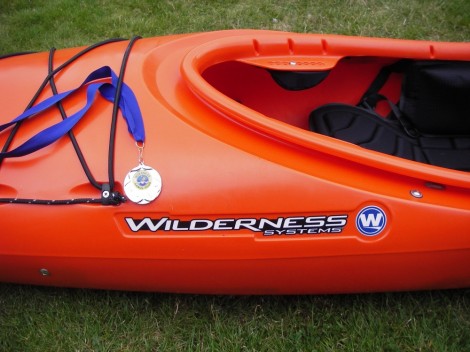
On Earth Day (April 22) of 2010 Dave Freeman and I began a three year, 11,700 mile journey across North America by kayak, canoe and dog sled. Our goals are to increase awareness and promote conservation of North America’s waterways and wild places while actively engaging over 100,000 elementary and middle school students in the journey though our website and live school assemblies.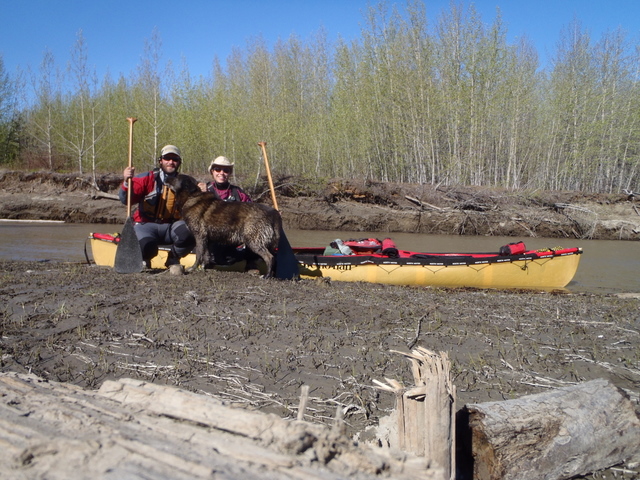
The odyssey began by kayak on the Pacific Coast studying temperate rainforests and marine life of the Pacific Northwest, but this was just the first in a series of six stages on their quest to highlight North America’s wildest places.
After kayaking 1,400 miles from Seattle, Washington to Skagway, Alaska, we progressed over the history-studded mountains in the footsteps of the Klondike Gold Rush, to the Mackenzie River delta. From there, we dog sledded south and are currently canoeing from Great Slave Lake toward Ontario. Then we will kayak through the Great Lakes and follow the annual whale migration past the salt marshes and sea turtles of the Atlantic Coast, finishing in the mangroves and coral reefs of the Florida Keys.
As you read this, we are somewhere in central Canada, working our way south and east in our canoe with our travel companion and favorite sled dog Fennel. To follow our progress and virtually immerse yourself in the expedition, check out www.NorthAmericanOdyssey.com. We are very excited to join the Palm Equipment Team and we will post regular updates on the blog.
This marks the first summer I haven’t traveled out west in a long time. The west coast gets all the glory for summertime paddling in the US and rightly so as California, the Pacific Northwest, Idaho, Montana and Colorado are all at their prime right now. However it doesn’t mean that you can fully overlook the right side of the country as there are plenty of quality options! Also as I’m still in the process of healing a herniated disc the East Coast offers me some great summertime paddling close to home and a chance to get to some places I haven’t been in a while.
The best part about kayaking in the East in the summer is the heat, and that means day after day in a shortie! It’s pretty good to be on a creek run without a dry suit and a bunch of fleece. Many folks think that the water goes away here with the end of spring, not so. Summer time thunder storms, some timely dam releases, and just plain big rivers lend themselves to great paddling all the way through the dog days of August.
This year with the start of the first heat wave I packed up the van and headed North for my first paddling trip since finding out I had a herniated disc. It’s been really good to be back on the water and traveling, two of my favorite things in life. Enjoy the pictures!
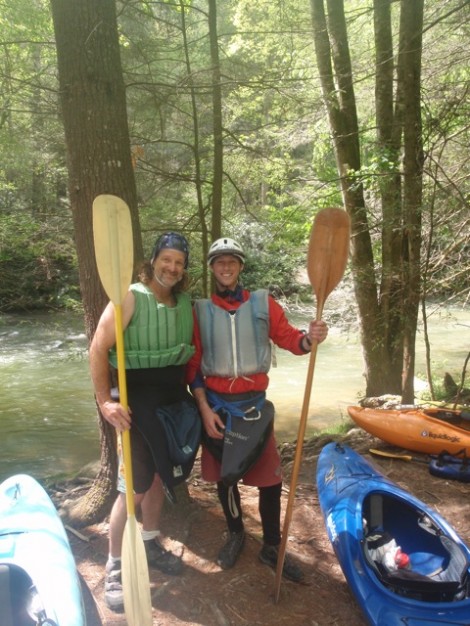
Wouldn’t be complete without a little Green River action in here. The Green is one of the best rivers ever in the summertime, lots of releases, good drops, and warm temperatures. Shane and I at the put-in on retro day.
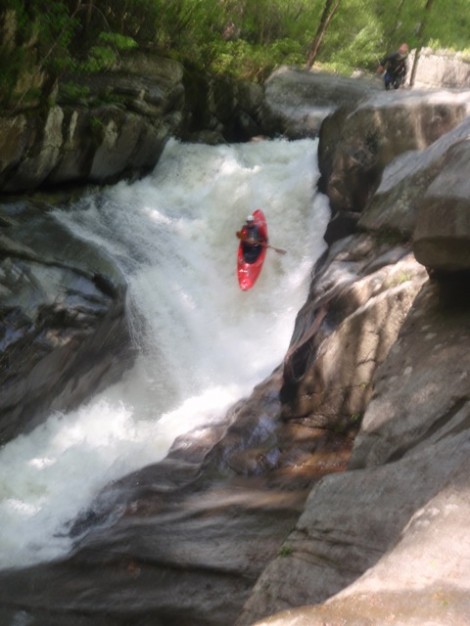
Rolling over Gorilla on Retro Day, good to be back in a boat and stomping this rapid. A 90 degree offset….well that was a little more challenging!
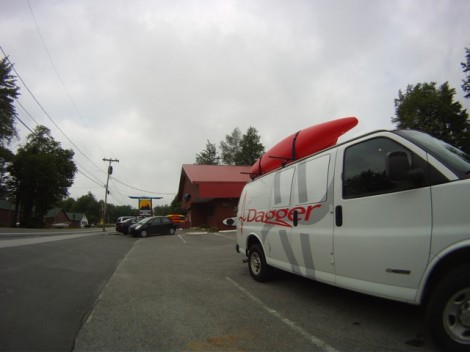
The van outside Moutain Man Outdoor Supply Company in Old Forge, New York home to the Moose River. Due to a lucky lightening strike the power plant was releasing water into the Bottom Moose which allowed me to get my first ever run on this iconic Adirondack river. It didn’t disappoint!
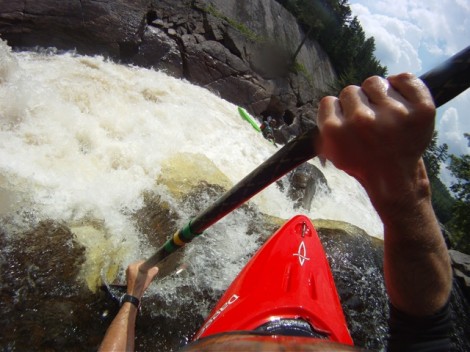
Lining up a boof on the Bottom Moose, I can’t believe it took me 20 years to get on this run. Glad I got to it I felt like I’d been doing the East Coast an injustice:)
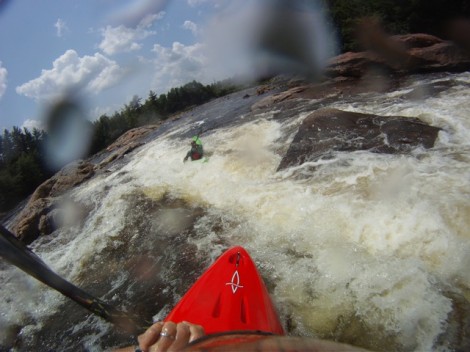
Following Will Crimmins down Sure Form one of the great slides on the Bottom Moose
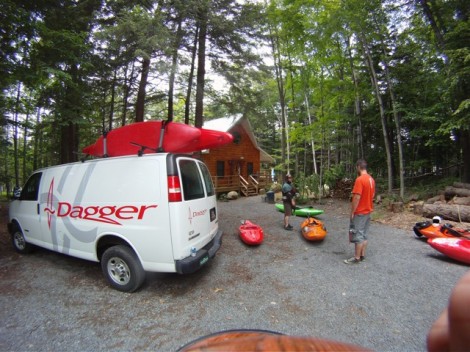
Another takeout after another great day on the water!
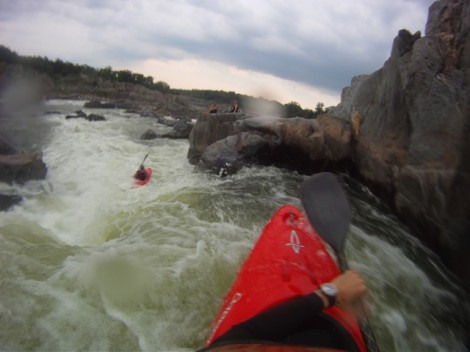
The view from Grace Under Pressure on Great Falls, Potomac River. Great Falls and the Potomac are one of the great urban jewels of East Coast kayaking. 20 miles downstream of this boof is the Whitehouse. It’s pretty cool kayaking resource as it has something for all levels of paddling right outside of Washington DC.
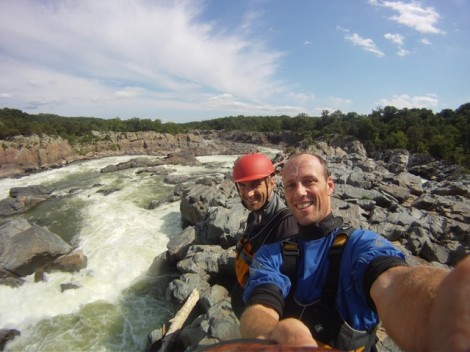
My cousin Ben and I at the Center Lines on Great Falls.
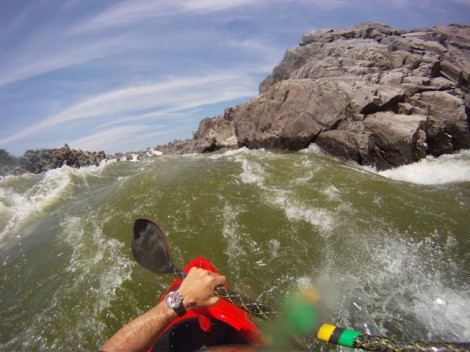
Shredding the O-deck waves in my Axiom! Great waves and great boat!
I think two of my favorite parts of a good road trip are the people you get to see and the random things you end up doing. It’s good to have a plan sometimes but sometimes you just gotta go with the flow….
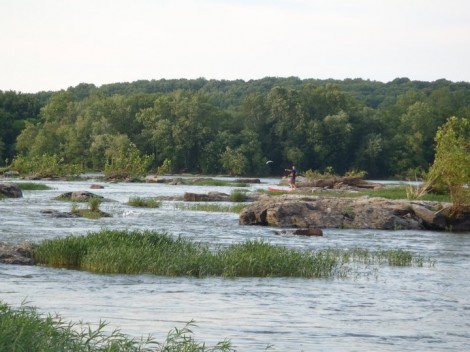
Stand up Paddle Boarding on an upper section of the Potomac
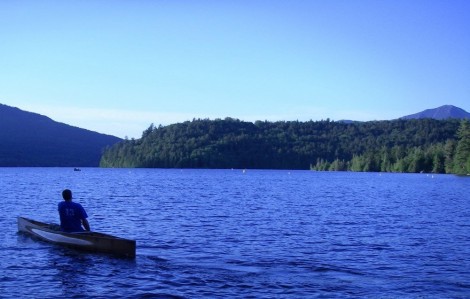
Evening on Lake Placid, New York. Can’t be afraid of some different craft, my friend Christian paddling home after drinks at the Lake Placid Lodge
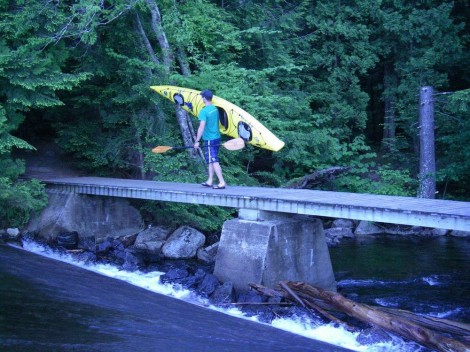
Speaking of different craft to where am I going with this again?…..
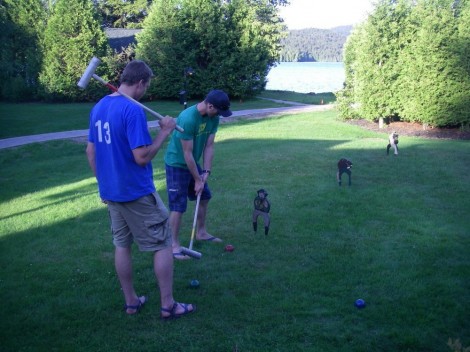
Never be afraid to take advantage of croquet
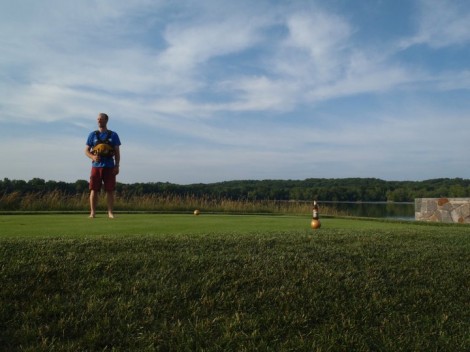
And above all never go anywhere without your PFD
Catch you next time and happy paddling on whatever craft this summer!
I was lucky enough this week to be joined by good friend and fellow paddler Chris Charlton, along with a group of first year degree students from UCLAN (University of Central Lancashire) who were studying a mixture Outdoor Leadership and Adventure Sports Leadership. We were based out of Ty’n Dwr Hall in Llangollen North Wales.
We had spent some time discussing our aims and had decided that a journey on Bala Lake was going to be the order of the day. It was a cold and frosty morning as we loaded the boats and sorted the kit, and this cold theme was to continue throughout the day. After a short drive through a wintry landscape, we arrived in Bala and made a quick stop for the all essential brew kit, chocolate biscuits and marshmallows to accompany our Kelly Kettle. Chris and I had introduced the group to and given them a few top tips and handy hints on how to light it the day before whilst paddling at Ellsemere.
Bala Lake or LLyn Tegid (Lake of Serenity) as its know in Welsh, is Wales’s largest natural lake and measures 4 miles (6km) long by a 1 mile (1.5km) Wide. It is crossed by the River Dee and its waters are famously deep and clear. Bala itself is located within Gwynedd in the Snowdonia National Park, partway between Llangollen and Betws y Coed and is easily accessed via the A5 which runs through North Wales.
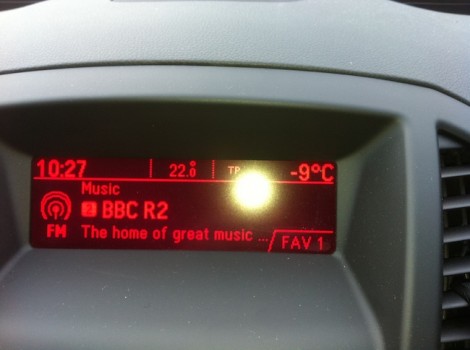
It was going to be a chilly one!
As we arrived at our launch point I noticed the in car thermometer reading a cool -9 outside! Today was going to be a tad chilly. We had chosen to launch a short distance from the normal shoreline due to the ice on the ramp down to the water. Instead we had opted for a layby approximately 200m further down the road on the Western side of the lake. This proved easier access with only a short boat carry down some steps to the water’s edge. There is a launching and parking fee payable for using the lake, so its a good idea to visit the Lake Wardens Office at the Bala end of the Lake, above the public conveniences prior to launching. You can then be advised on where to launch, weather and any events etc that may be happening. There is also a Watersports Centre (Bala Watersports) based on the lake with hire facilities.
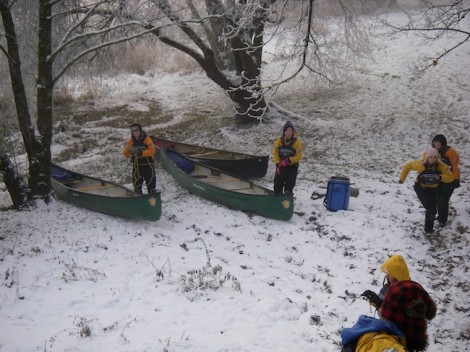
getting the boats to the water
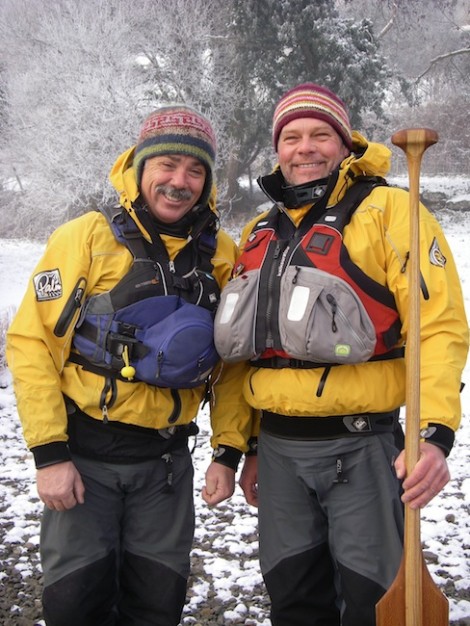
The Chuckle Brothers - me & Chris
As Chris and I got down to the waters edge, the view was stunning and reminded me of the sort of thing you might expect to find on a Christmas card, very white and crisp. There was a mist hanging around over the water producing a very picturesque scene, with every now and then a quick glimpse of the sun. The students even commented on its resemblance of a scene out of Narnia. I have only experienced theses near perfect conditions once before on Bala Lake and it really is hard to try to describe them. I guess you would just have to have been there!
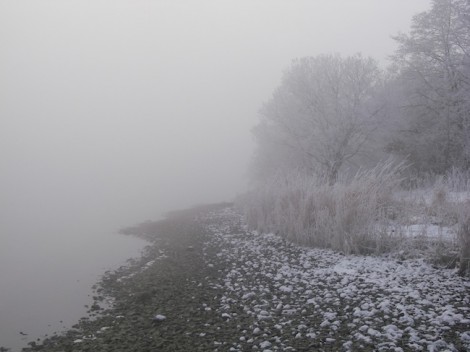
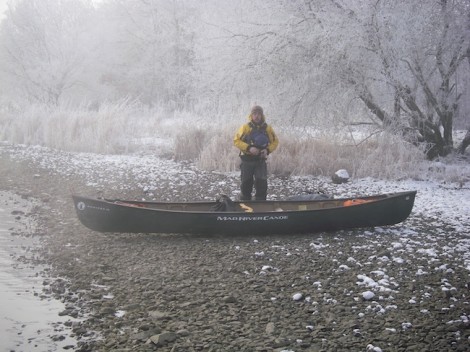
Jules, do I really have to go paddling? Its cold!
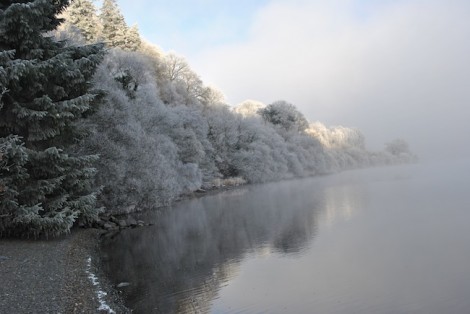
One of the many glimpses of the sun
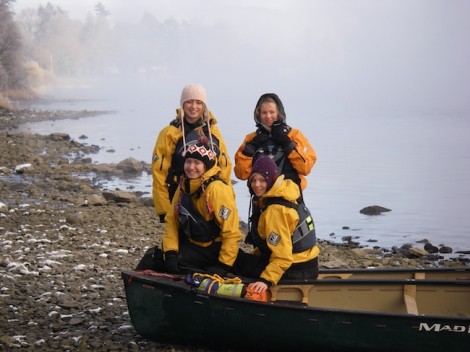
Smiling faces and ready for a paddling adventure
Boats loaded, group briefed we set off into the mist and headed south down the lake keeping the western shore to our right even though we couldn’t see it! It really was cold as we paddled into the magical silence except for the occasional splash from our paddles.
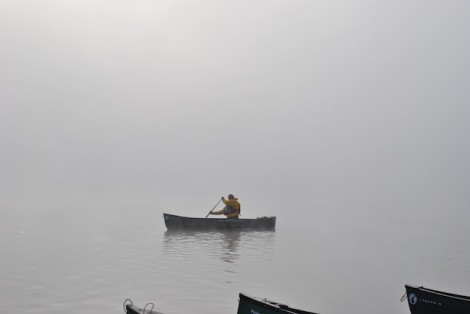
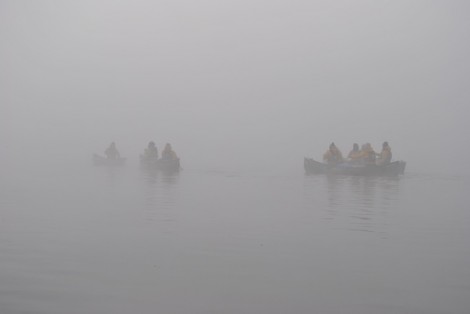
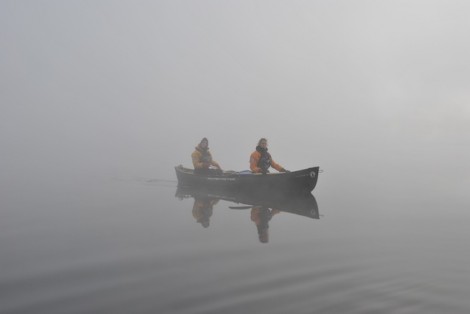
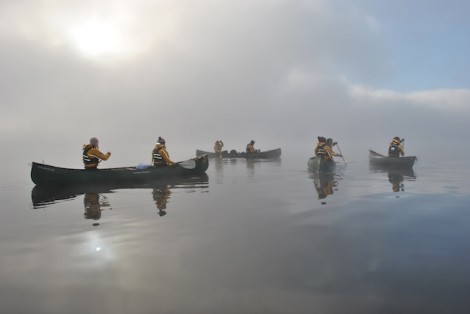
As we paddled along there were more frequent breaks in the mist and glimpses of the sun all adding to the ambiance. During one of these breaks we caught a glimpse of a small cottage on the shore. This seemed like an ideal place for a leg stretch, some lunch and a brew courtesy of our Kelly Kettle.
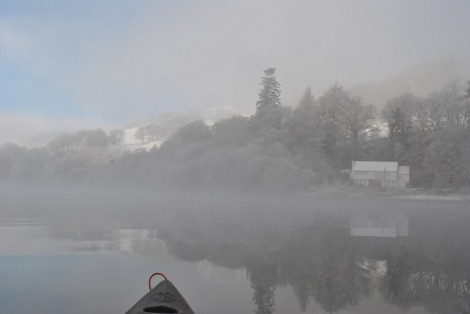
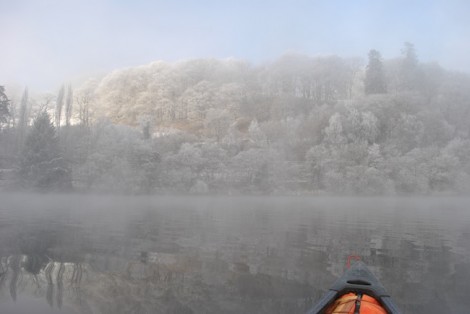
Kelly Kettle’s always seem to go down well with groups. I tend to show people how to light them using Birch bark and a firesteel. My preference for a firesteel over matches or a lighter is that it will still work even when it is wet.
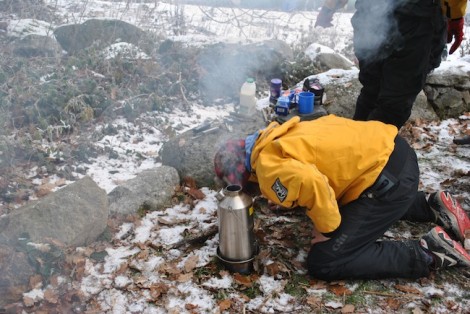
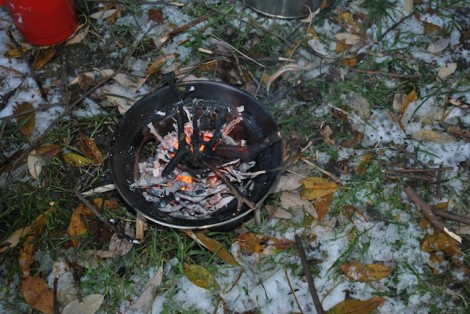
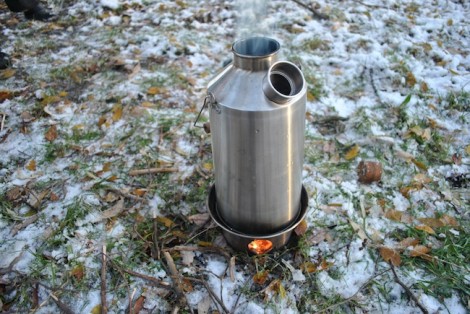
Lunch over with it was time to continue on our journey. So boats were packed, launched and we continued, but first we spent some time revisiting some of the core skills needed for paddling a canoe tandem.
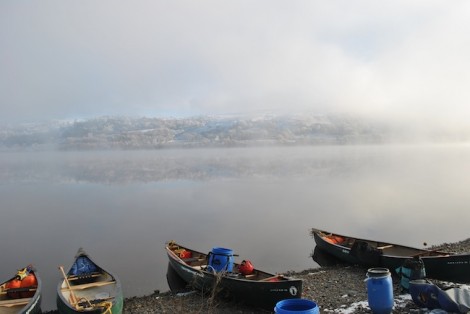
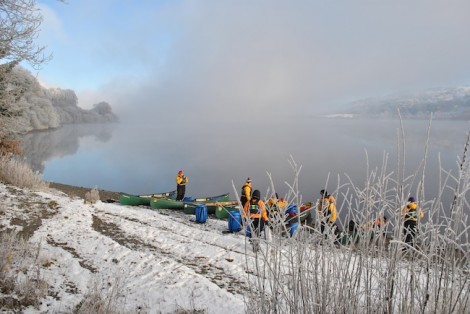
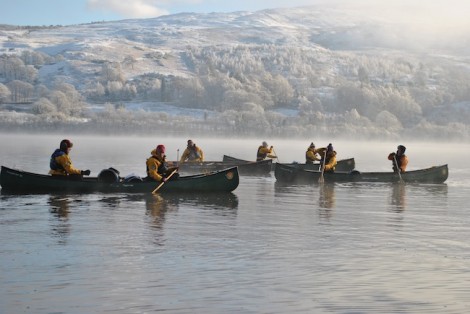
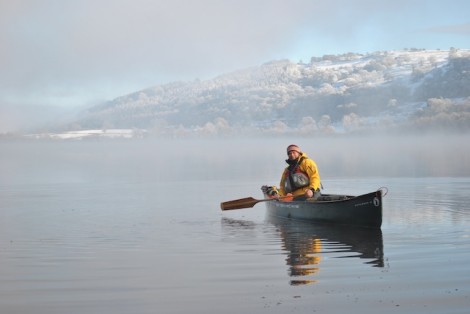
I had chosen my two favorite deep water paddles for the day, both of which were hand made for me by a friend. I am hoping that in the new year he is going to educate me in how to make my own. So Andy if your reading this, big hint!
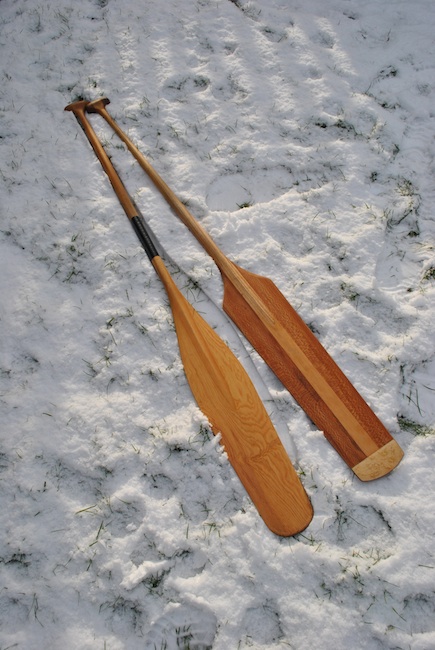
My deep water paddles. Otter tail (L) & Voyageur (R)
Both paddles are well suited to cruising on deep, flat water due to their low aspect. I suppose you could even consider them as your 4th & 5th gear, as opposed to a white water paddle being 1st & 2nd gear. The reason for the Voyageur’s distinct yet simplistic shape is two fold. Firstly it was easy for the Voyageurs to carve with its straight sides when on the trail, and secondly the obvious shoulders makes sure that any water drips run off here, rather than running down the shaft to the paddlers hands.
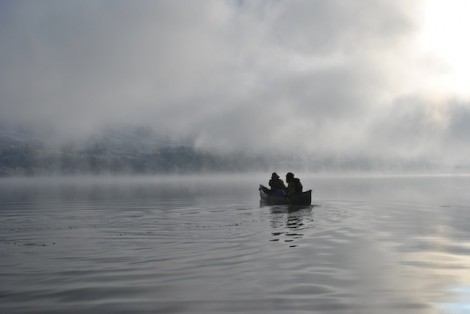
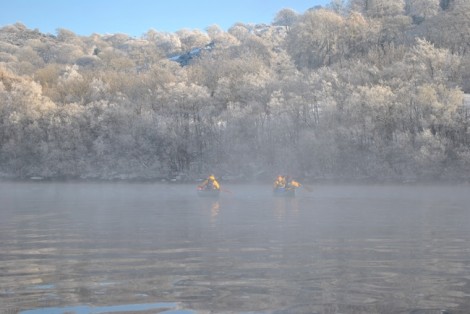
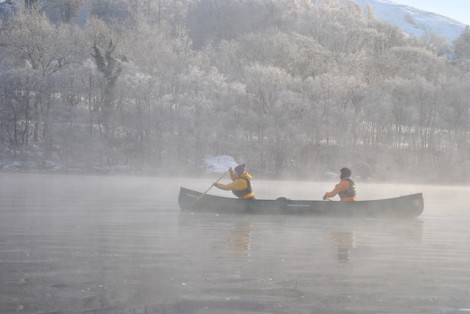
As we paddled once again into the mist the sun and blue sky was now becoming more frequent, and it wasnt long before we reached the eastern shore not far from Llangower Point. From here we headed North up the lake before finally heading back to our start point.
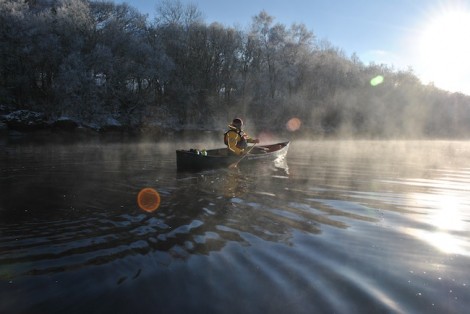
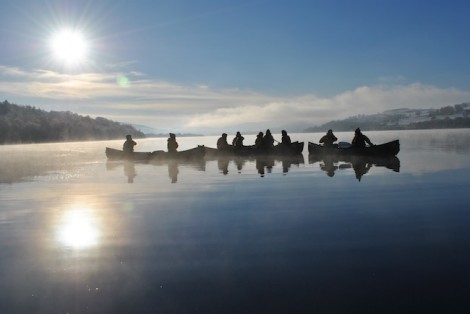
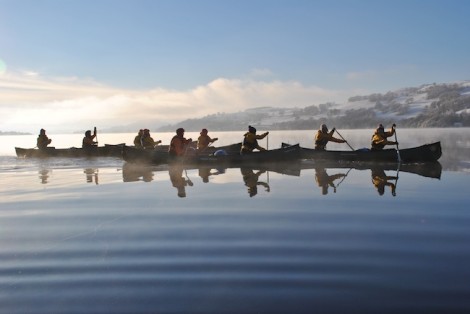
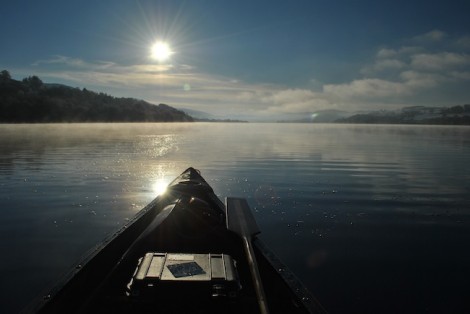
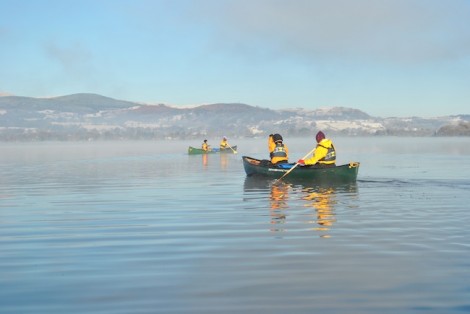
Once back safely on shore it was time for one last brew from the Kelly Kettle and an opportunity to finish off the chocolate biscuits and marshmallows.
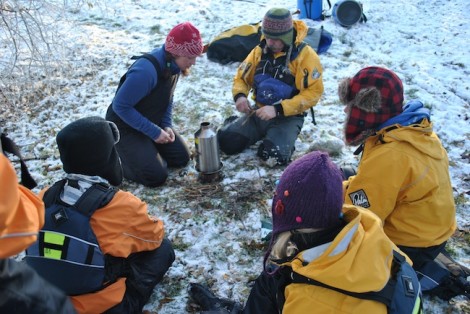
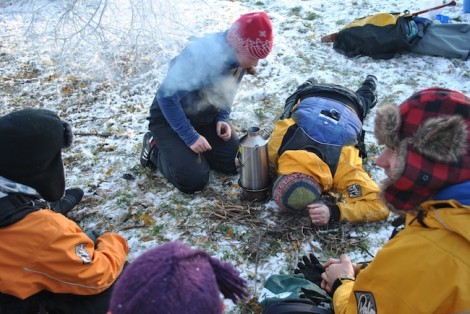
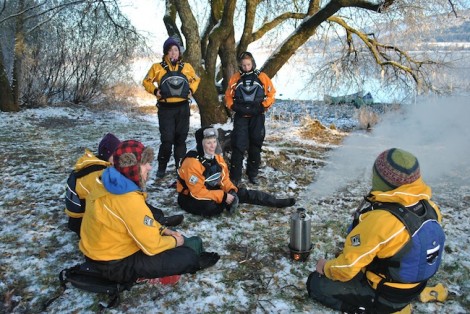
A great ending to a great day, especially in those conditions. I shall leave you with my final view of the day as the sun set.
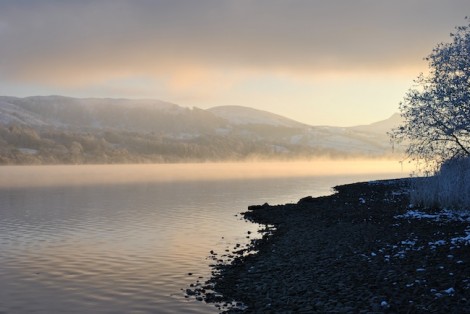
Looking back over Bala Lake as the sun sets
You can see all the photos from our day on the Voyageur Facebook page here.
See you on the water…
Jules
www.voyageur-coaching.co.uk
Any one that knows me will tell you that Rannoch Moor has to be one of my favorite remote/wilderness spots for a paddling adventures in Scotland. I have completed the cross Scotland trip starting at Kinloch Leven and finishing at Perth a number of times and never tire of it, but I had not completed the trip via the the smaller Lochs Ba and Laidon. So inspired by Justine Curgenven’s recent DVD release, “This is Canoeing” I decided to go and investigate the area in preparation for a future trip.
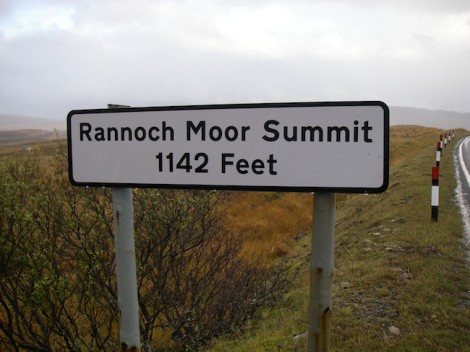
Rannoch Moor - Does what is says on the tin!
Rannoch Moor lies in the Scottish Highlands and can be accessed via the A82 as it winds its way from Glasgow, through Crianlarich onto Glencoe then on to the west coast and Fort William. Due to its height above sea level, its location in relation to the west coast and its weather, expect the climate to be unsettled, often bringing snow, sleet and heavy rain throughout the year. This trip would prove to be no exception!
As I was heading over to Ballachulish for the night and looking forward to the prospect of visiting the Clachaig Inn for a pint of Guinness, I thought I would check out the start point for my planned trip. My start point, Loch Ba is said to be one of Britain’s most remote and windswept points, as the A82 crosses over to Glencoe, and at a height of 1142 ft above sea level. The surrounding area is covered with numerous lochans, streams, peat bogs and mountains that rise on all sides to over 600m and in some cases alot higher.
On arriving at Loch Ba I felt a little deflated as I became aware of some quite serious looking roadworks going on right were I had intended launching! Not to be deterred I headed back from where I had just driven a short distance and in actual fact found a better launch spot with good parking on the opposite side of the road at Lochan Na Achlaise. Winner! The weather was cracking, the views were stunning and I was looking forward to my forthcoming adventure.
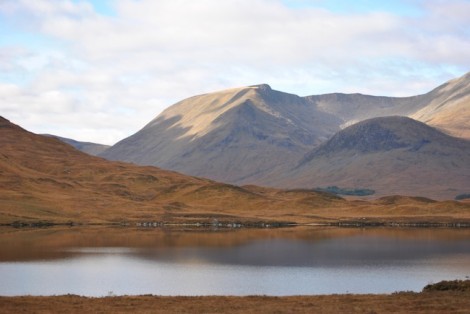
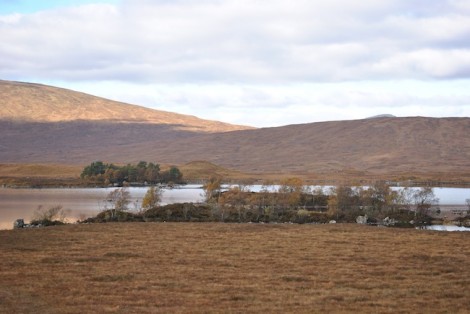
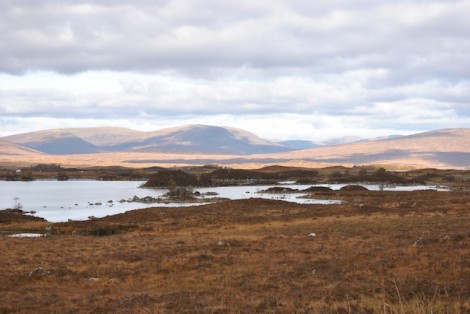
Looking across from my start point Lochan Na Achlaise, on a dry day!
The morning after my recce and visit to the Clachaig Inn dawned a little different to the previous day! It was poring with rain and blowing a gale, and this was at sea level. Not to miss the opportunity I ventured out and drove back up the Glencoe Pass to my start point.
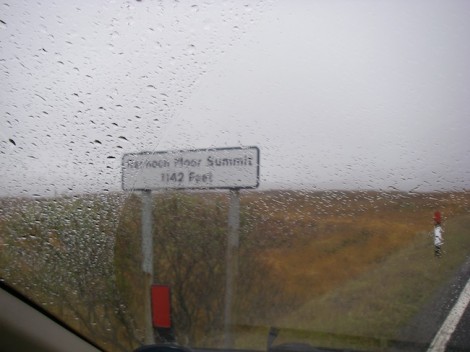
Not quite as I had remembered it form the previous day!
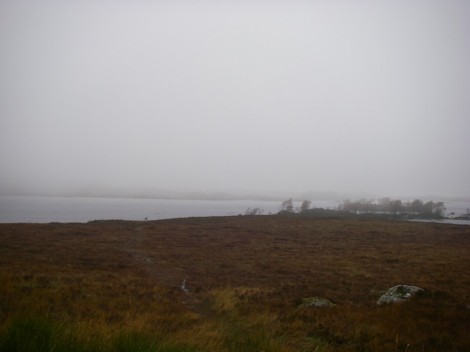
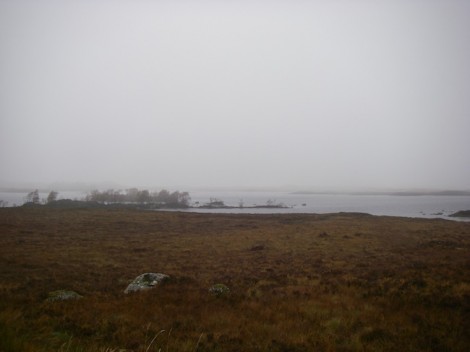
A different look to Rannoch Moor
My plan now was to head out of Loch Na Achalaise via a tributary that fed into Loch Ba. Then to paddle its length and again pick a tributary this time leading into Loch Laidon, then continuing on to Rannoch Station, an over night bivy and reverse the route back to where I had started. Easy!! Or not as the case may be.
As I unloaded my boat and kit in the wind and rain, a figure emerged from a rather steamed up 4×4. This turned out to be a guy visiting from Norway and in some broken English asked me as to my intentions. At this point he looked somewhat shocked, wished me luck and diapered back to the steamy 4×4.
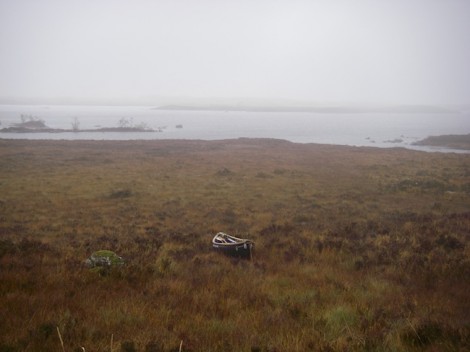
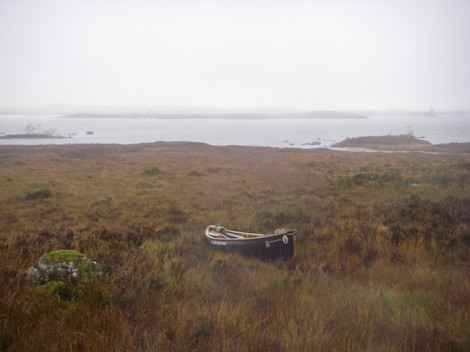
Getting my boat down to the water
As I unloaded and launched my boat etc I became aware of a very strange noise coming from the mist. After having heard it several times it dawned on me as to what it was, a roaring Stag! At this time of year the Stags are in their rutting season and competing for the females (Hind). This roaring is a very distinct if not unnerving sound especially when it is coming out of the mist and you cant actually see whats making it. The Stags roar in order to maintain control over a group of females and to constantly drive away rival males. I was now hoping I might catch a glimpse of one of theses magnificent beasts roaring. Bit difficult in a bright yellow cag though!
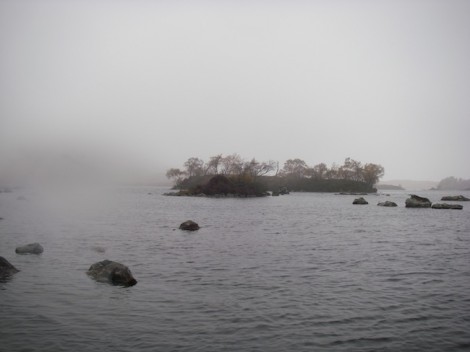
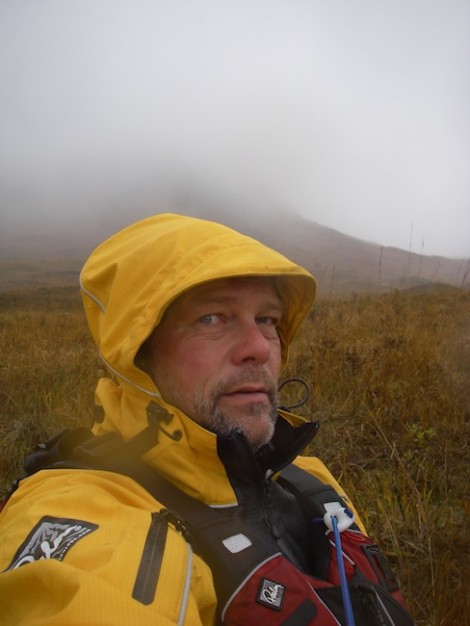
Time for a break whilst keeping an eye out for Stags
The weather was definitely getting worse, and I was beginning to think that maybe I wouldn’t make my goal and more to the point was this such a good idea? After a brief chat with my self I decided to continue and seek shelter under a small bridge over which the A82 ran and have some lunch. This comprised of some brown biscuits and vegetable spread followed by some fruit biscuits and chocolate all left over from a military ration pack I had recently used for some work.
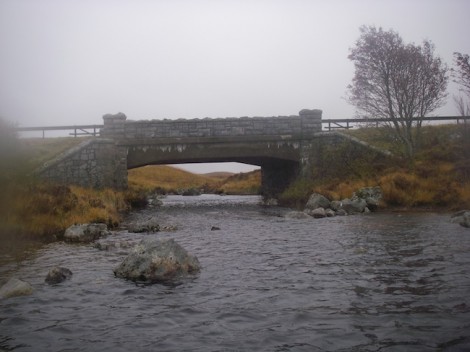
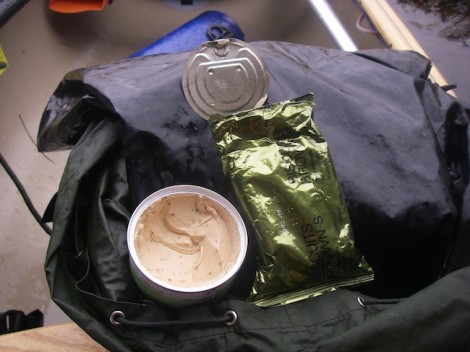
Lunch and a blast from my past
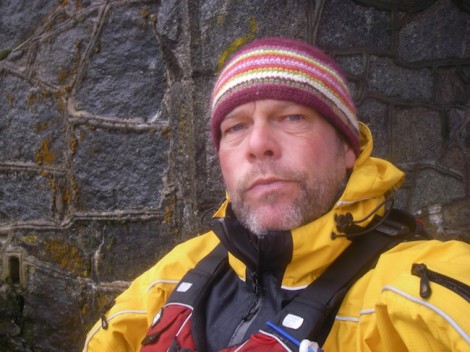
Savoring the exquisite cuisine
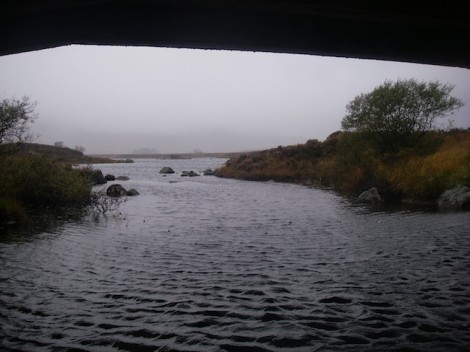
Looking back into Lochan Na Achlaise
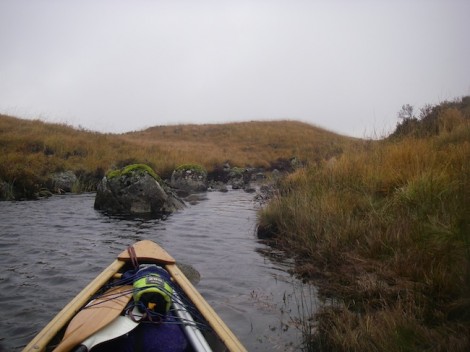
Time to portage
After my brief lunch it was time to move on, however as you can see from the picture my path was blocked largely due to a lack of water. My only option now being some form of portage. The ground was to too soft and boggy for a trolley, plus I’m not really a big fan of them. Carrying my boat on my shoulders with the aid of the Yoke was also not an option due to the soft uneven ground. This left me with the only option. Dragging! So I rigged a quick harness system and used the two half’s of my canoe pole like ski poles and set off looking something like a Polar explorer man-hauling a pulk. It wasn’t really possible to carry kit and drag my boat so I decided to carry my kit a short distance first and whilst doing so I could identify a suitable route to drag my boat along. Once my kit was dumped I could return unloaded and collect my boat. I use a similar routine when carrying my boat and adopt a preference for quite short legs or stages as I go. A stage was a convenient stopping place used by Voyageurs at which loads were dumped, and they were generally around six minutes apart. This being the length of time a man could walk with a good load without fatigue. The idea is that he would recuperate on the way back for the next load. It was taken from the native Indian system of packing allowing better time to be made.
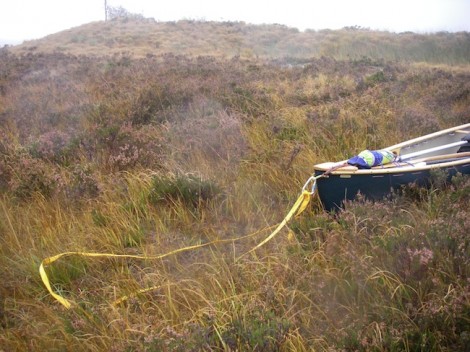
My simple harness
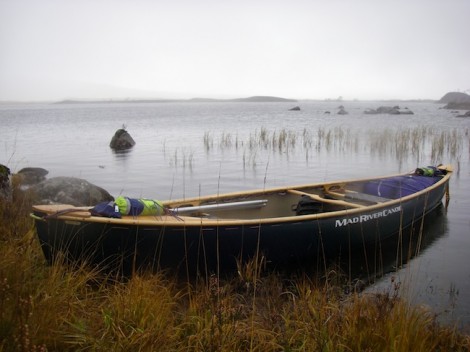
I eventually arrived at the start of Loch Ba and wasted no time continuing on my trip. However as I was about to get into my boat I noticed something moving in the grass. On closer inspection I discovered I had a friend in the form of a small frog!
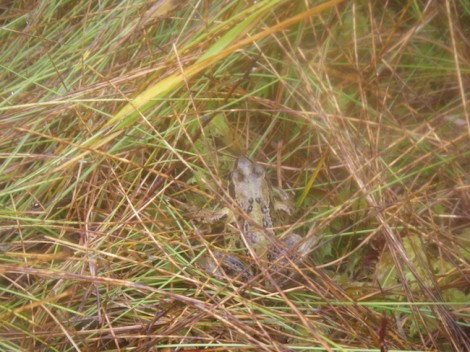
My little friend
Loch Ba is approximately 2.5 long and eventually leads into the River Ba which flows into Loch Laidon. It was around this point that the weather calmed down for a while and I was again aware of that haunting sound of the roaring Stags. I decided that as the noise seemed close I would investigate further and see if I could locate the Stag and possibly get a picture. I set off and sure enough during a brief break in the mist, a large stag in all its glory appeared about 150m in front of me, with another one on top of a rise some distance way. Between them was a group of 5 or 6 females (Hinds). I decided to try my luck and get closer, but as I have already said being in a bright yellow cag probably wasn’t the best idea. As I got closer and with one last roar the closest Stag took flight and disappeared with his hareem. I quickly grabbed the chance of a picture. Its not the best but here it is.
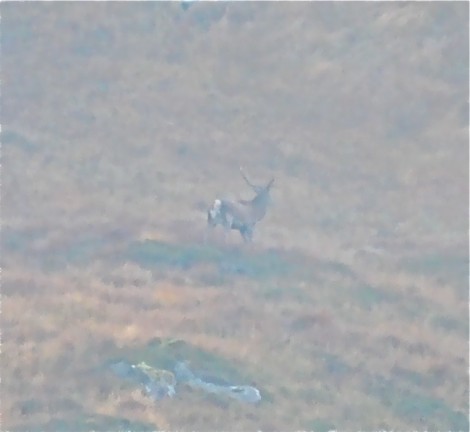
The Roaring Stag
After another couple of km dragging, carrying, poling, lining and paddling I entered Loach Laidon. This now felt very remote and wild and despite the weather the scene was stunning, I had a real sense of pleasure getting here. As if by magic a Royal Navy search and rescue helicopter appeared very low but above me. It was so low infact I could clearly see the pilots face. I guess they were just wondering what or who was up there dragging a canoe around in this weather. The side door slid open and the winch-man appeared signaling to me an OK sign with his thumb. I returned the gesture with both thumbs and with he a big smile on his face he returned in side, closed the door and as quickly as it had appeared it disappeared. A quite surreal experience!!
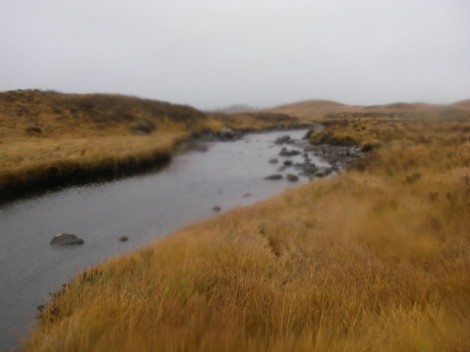
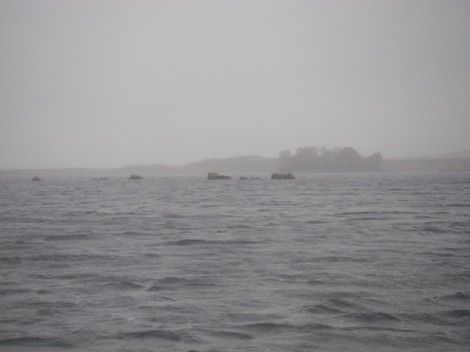
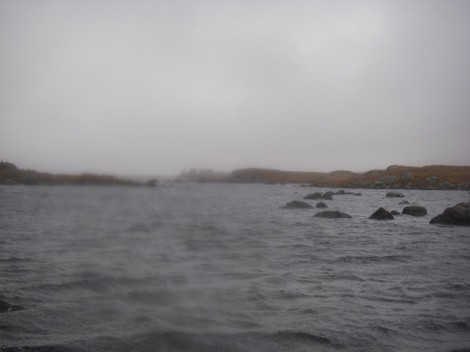
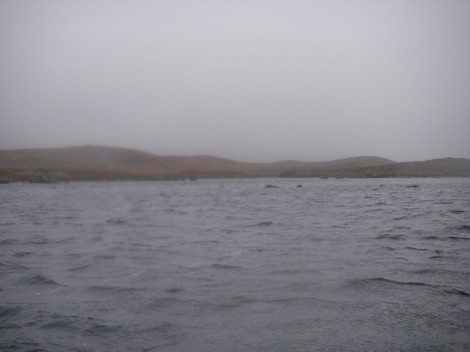
Unfortunately at this point my camera gave up the will to live! So no more pictures. I was now quite aware of time and the weather, as I had pretty much had the wind behind me all day aiding my progress. I was now just over half way down Loch Laidon and the weather was definitely worsening. If I cut my journey short now and started heading back I would probably make it back to the car that night. If I pushed on to the end of the Loch I couldn’t guarantee finding a suitable bivy spot, and if the weather deteriorated yet further over night then I couldn’t be sure I would get back.
Decision made I turned around and headed back. Batting into the wind was no pleasure I can promise you. By the time I reached the car the light was fading and I was tired but happy.
I now had a good idea of what would be involved when I attempt a crossing from here later next year. Another thought is to start down near Oban, up Loch Etive and then portage Glen Etive via road and tracks to reach Loch Ba and then continue the crossing via Loch’s Rannoch and Tummel etc. Either way it will make for an interesting tale.
Rannoch Moor really is a special place and I would encourage you to go and paddle it for your self. Remember though it is a serious trip and a remote environment so make sure you are well prepared for the weather you may encounter and carry the right safety kit.
Meanwhile I’m busy planning a winter trip starting at Mallaig journeying to Loch Arkaig and on to Fort William or even Ballachulish.
See you on the water….
Jules
www.voyageur-coaching.co.uk
Over the weekend we donned dry suits and took a few Mad River Canoes to join around 50 other paddlers taking part in the ’Rubbish River Run’ clean up paddle on the River Usk in Wales.
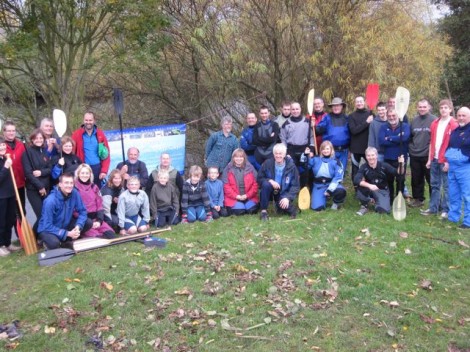
The river clean team ready to go
Flowing through the Brecon Beacons National park, the river Usk boasts a number of classic UK whitewater sections popular with paddlers through the winter months. In light of this the park authority have put paddling firmly on their radar with the launch of Splash, an initiative aimed at bringing together groups who use the river and other local water ways recreationally.
The Rubbish Run was the brainchild of Gez Richards, the parks recreational development officer. With help from local outdoor centres, paddling clubs and Tidy Wales, he decided it was time to raise paddler’s awareness of our role as custodians of the river environment and of course as a keen paddler himself, to get some profile for paddling activity in the area whilst doing it.

Tools for the job
Meeting up in the town of Brecon for a photo call and briefing, groups were allocated different sections of the river covering around 20 or so miles in total. Equipped with refuse bags, litter pickers and grappling hooks for any larger items, everyone went off in search of rubbish. Most debris found on stretches like this is a mix of plastic bags, litter wrappers and agricultural material, which gets caught up in the trees on either bank. Apart from the eyesore the real danger is for wildlife either eating or getting tangled up.
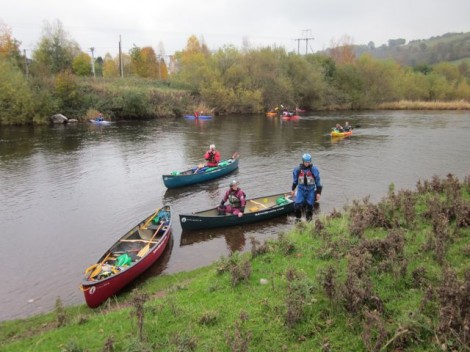
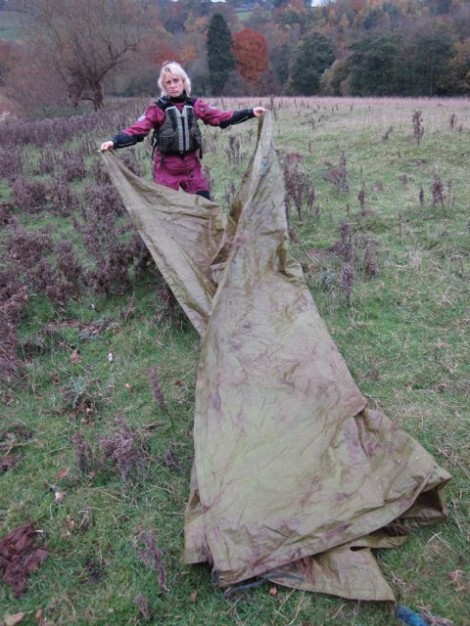
By the end of the day 54 full refuse sacks were collected and deposited at nominated roadside locations where the local refuse collectors had agreed to pick them. Along with the bags we also found a motley collection of rusting bikes, old tyres, gas canisters bits of drain pipe and a see-saw – quite a haul!
A big thanks to Gez for organising and all of the paddlers who turned out. If you are doing anything like this in your area let us know and we’ll give you a plug.
